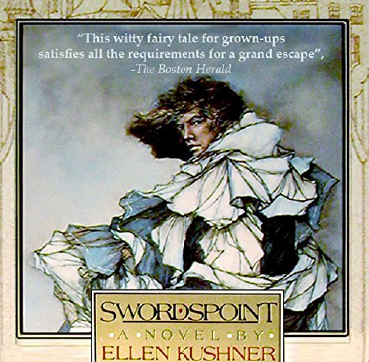Illuminating the World of Swordspoint
When I first approached Ellen Kushner about the possibility of producing her classic novel Swordspoint: A Melodrama of Manners as an audiobook, it was right after we had completed the Ear Phone Award-winning production of The Witches of Lublin, which she had written with co-authors Yale Strom and Elizabeth Schwartz.
In directing Witchesas a Passover holiday special for public radio and CD / download release, I chose a highly realistic sound design to help better immerse the listener in Lublin, Poland, in 1797. An original score by Yale Strom, performed by his band Hot Pstromi, underscored and supported the drama of Rivke and her family, as this group of independent women klezmer musicians tries to live between the traditions, social standards, and prejudices of both the Jewish and Polish worlds of the late eighteenth-century. Sound effects, many recorded on location, were mixed with commercially released pre-recorded sounds to bring the play’s scenes to life.
But Swordspoint would be a full-length audiobook, not a one-hour drama. In considering how to produce Swordspoint, we recognized that time and budget would not allow for such extensive production techniques. Author Ellen Kushner, already an experienced and well-known national public radio host and sometimes stage actor, was interested in narrating her own book. As we were working through Audiobook Creative Exchange (ACX), I decided to commit to engaging Ellen as a full partner in the process of bringing this book to life, something that does not often happen when a book is being produced, however, I wanted to truly serve the story and characters and given our recent collaboration on Witches I felt together we could achieve the best interpretation of this novel.
As I began to read Swordspoint, I began not only to hear Ellen as the narrator, but to hear the characters themselves. Her characters are written so completely that each voice sounded clear to me and I wondered if the audiobook could benefit at all by the addition of a small cast working alongside Ellen’s narration for part of story.
Once I began to hear the possibility of other voices working in harmony with Ellen, I also started considering what the audiobook might sound like if I added a small amount of sound design: music and sound effects to further enhance and ultimately ‘illuminate’ the overall work.
In speaking to Ellen about what I was hearing, I suggested we produce an audiobook that was a hybrid between what is traditionally produced: the solo narrator, where Ellen would read a majority of the book using her acting skills and intimate knowledge of the characters she has created to bring Riverside to the audio marketplace, combined with audio drama techniques including actors, sound effects, and music. To retain the status of the book as “unabridged,” we would retain Ellen as narrator throughout, even in those scenes.
We agreed that our choices of dramatized elements would be determined by the flow of the book, aesthetics, and budgets. We decided to begin by selecting moments of the story which we could illuminate with a cast of actors.
How did we specifically choose those moments? Through ongoing discussions with Ellen I began to understand, on a deeper level, the intricate nature of her plot and characters. This helped me to suggest moments, scenes, and chapters where we could bring not only more color to the book through the use of other voices, but also help to create clarity in those scenes which were dense with multiple characters.
I was then able to negotiate a contract with AFTRA that allowed us to afford, and hire, a group of wonderfully talented and skilled audiobook actors including Dion Graham, Katherine Kellgren, Simon Jones, Nick Sullivan, Robert Fass, and Anne Bobby, among others.
I first directed and recorded Ellen’s narration, which created a template for the ‘sound’ of each character. This in turn made it possible for me to direct the actors more specifically and easily to almost ‘match’ Ellen’s interpretations.
Once all the actor voice tracks had been recorded (and while they were being edited), the next question became, how much sound design to incorporate? How much music, if any? And when should sound effects should be used in the story, if at all?
My concern was to ensure that moving from one production style to another would not confuse the audience. I wanted to make sure we were creating smooth transitions between Ellen’s solo narration and the dramatized moments.
I decided that creating and maintaining a somewhat similar level of sonic texture between Ellen’s reading and the full cast scenes might be what established a level of environmental continuity, which would carry the listener from one moment to the next.
To achieve this we thought that music might be the key. Our Master Engineer for SueMedia Productions, David Shinn, had just recently worked with a very talented and gifted young composer, Nathanael Tronerud, whose specialty was original underscore for a number of entertainment media, including TV and Film. We contacted him and found that a book like Swordspoint was right up his alley.
As Ellen had very specific ideas about the music that best expressed the book’s unusual tone and setting, I asked her to participate in the initial discussions with Nathanael about her “melodrama of manners,” and as he began to compose and record our opening theme and the first character motifs, Ellen gave feedback, so that Nathanael and I could complete the score confident that the music had captured the emotional feel and energy of the book. As I wanted a variety of themes to help foreshadow moments, create suspense, and bring the actual music happening in scenes to life, we also solicited a few musical elements from other sources and composers to add to Nathanael’s wonderful and original score.
All this music allowed us to design a sonic signature for the book, so that we could bring the listener along from “Ellen Only” narrated chapters, to those performed by our cast, and back again, throughout.
The last layer in our illuminated production to consider was sound effects. Ellen and I went through the book together and discussed where my suggested sound effects might work best. As British screenwriter Paul Cornell’s recent review of the audiobook (http://www.paulcornell.com/2011/12/12-blogs-of-christmas-seven-ten-… ) said, “That’s quite a tightrope to walk, and in lesser hands the effect could be terrible, an awkward halfway house between drama and reading . . . ”
Keeping this concern always in mind, we continued to evaluate our choices in the final mixing stage. I continued to ask myself:
- Does the cast enhance Ellen’s reading and bring clarity to the listener?
- Does the music support the narration, the dramatic moments, and act to move the story forward?
- Do the sound effects breathe life into the sword fights, streets, houses, and taverns of Riverside and the Hill?
I even sent test chapters to associates who are fans of both traditionally read audiobooks and fully realized audio drama to see if there was anything jarring in the transitions or in the varied way we had chosen to produce this book.
We even sought the ear of an expert in historical sword fighting to tell us if we had too much swordplay or just enough.
As the feedback supported my aesthetic instincts, we continued to mix the book so that all 11 hours maintained the same illuminated sound and energy throughout. And in the end, it seems we created what we had hoped. As Paul Cornell concluded: “. . . [I]t works wonderfully, the effect being akin to Ellen having an impossible vocal range, as the voices of the characters still seem to spring from her narration.”
Now that I’ve completed one “illuminated” production, I’m beginning to wonder what else might lie in store from the studios of SueMedia Productions.


